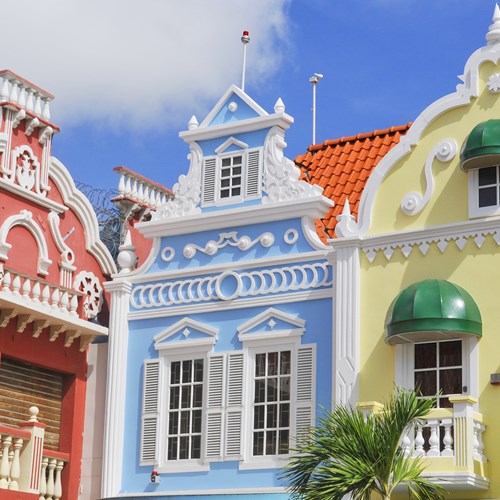
Aruba, Aruba
Sun-drenched beaches sit next to the desert wilderness in Aruba, one of the most popular destinations in the Caribbean. With warm and sunny weather all year round, the island seems frozen in a timeless holiday atmosphere, with turquoise ocean waters washing over Aruba's soft warm sand. Nightlife bursts with Latin music and exotic sounds, and exciting shopping and dining await at every corner. Stronger waves break against the eastern coast, deserted and swept over by wind -- exploring it will lead the most adventurous visitors to spectacular vistas.
Population:
106,314 (2019)
Currency:
Aruban florin, 1 AWG = 100 cents
Emergency Numbers:
Ambulance and fire brigade: 911
Police: 100
Hospital in Oranjestad: +297 527 4000
Opening Hours:
Many shops are open approximately 9am–6pm. Some of them close for a break between 12–2pm.
Newspapers:
Aruba Today (English) - www.arubatoday.com
Amigoe (Dutch) - www.amigoe.com
Diario (Papiamento) - www.diario.aw
The Island

Sheltered as it is from oceanic winds and tides, the north-western area of Aruba has become a holiday heaven, perfected by the tourism industry. Whether swimming in the calm blue water, snorkeling, venturing to do some water sports, or joining beautiful sunset cruises, it's quite difficult to get bored there. Funny flamingos and refreshing divi trees are characteristic parts of the scenery. You'll find the best entertainment in the popular areas of Palm and Eagle Beach, and in Oranjestad, the charming and compact capital city.
When looking for accommodation in this popular area, you have two main options. The high rise hotels are huge beachfront palaces located in the busiest and most central position. One mile north from there, low rise hotels offer a more private and relaxed atmosphere.
A visit to the more genuine town of San Nicolas, in the southern area, will be rewarded by hidden food gems and beautiful views. Reach the wind-swept Eastern coast and you'll find yourself in an undeveloped natural treasure (which can, of course, be explored as part of plenty of guided tours).
Aruba has a fascinating history of pre-Columbian tribes, colonization, and peoples' encounters. Arawak Amerindians came to the island around 1,000 BC and stayed for millennia; traces of their presence are left in the ancient wall drawings of Fontein Cave. After being discovered by European explorers, the island was colonized by Spain; fortunately, it was never big on slave trade, because the climate was too dry for plantation settlements. The Netherlands took over in the 17th century and ruled until the first free elections in 1986. Oranjestad preserves beautifully restored Dutch architecture from the Colonial period.
Do & See

Unwind on the pristine beaches, forget about the rut of everyday life exploring the dining and nightlife scenes, or catch some thrills taking part in water sports and outdoor exploration. However you decide to experience it, Aruba has all the trappings of an all-around perfect vacation destination.
Dining

Aruban cuisine is a mouth-watering fusion of cultures -- mostly Spanish, Dutch, French, and African. Specialities like goat cheese and funchi, the local variation of polenta, are must-tries. Dining in Aruba is also about the setting and the experience: you will find restaurants located right on the sand, or in picturesque manors. There are plenty of cultural influences, and -- as hard as it can be to believe it -- very affordable options.
Cafes

While relaxing on the beach all day, or jumping from one exciting experience to another, you will likely need a proper coffee break. Stay hydrated with fresh fruit smoothies, find sweet comfort in local desserts like kesio (a local version of creme caramel), or go full tropical with the banana chips snacks. Also, discover some great spots in the less touristy parts of the island.

